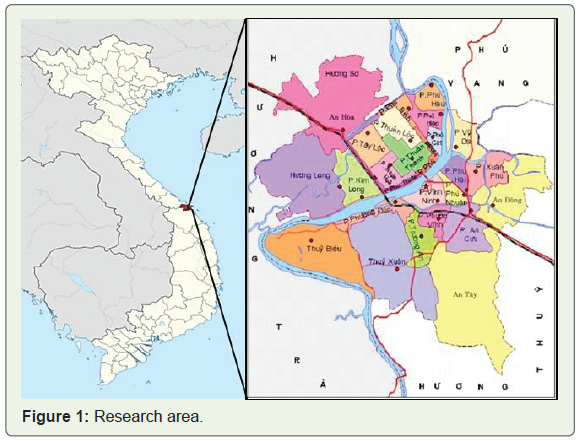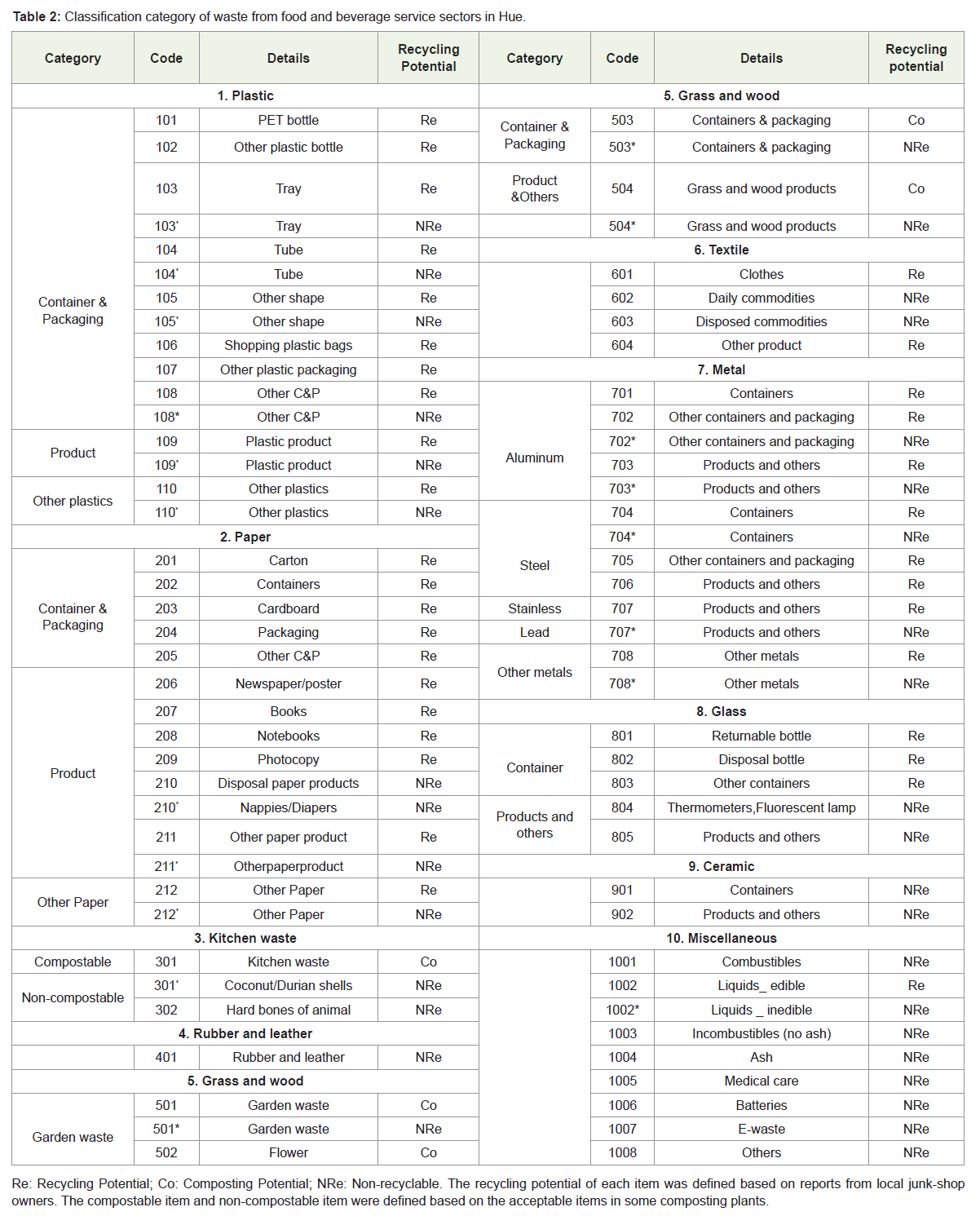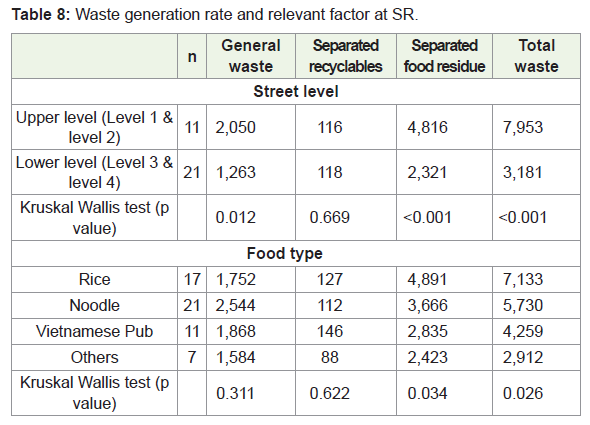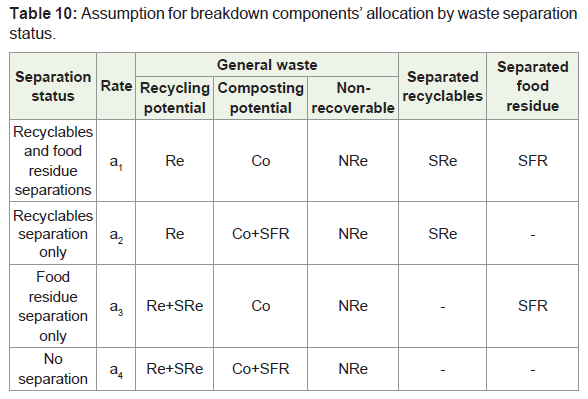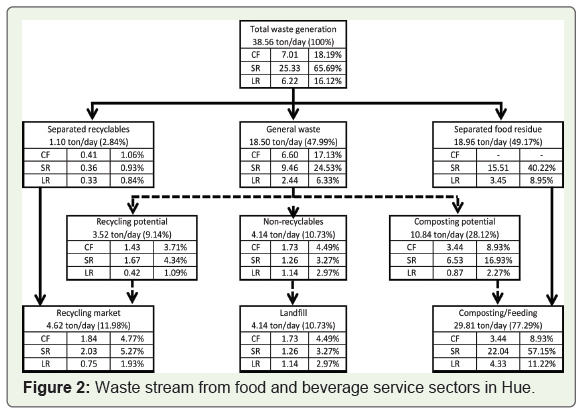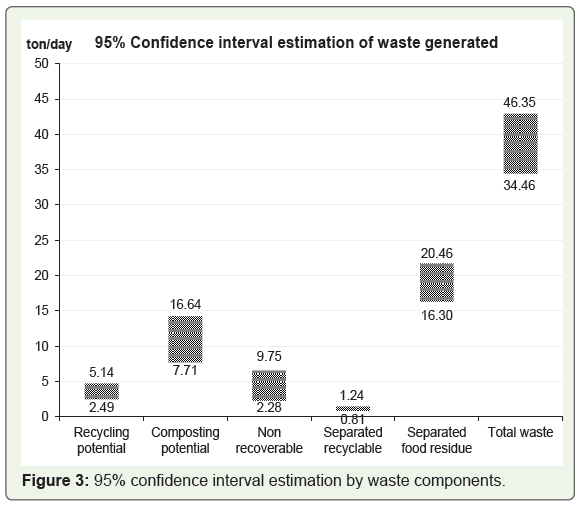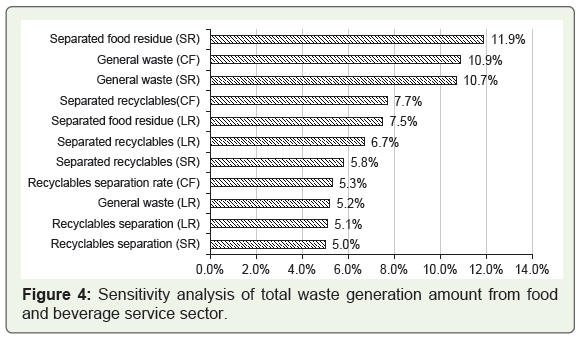Research Article
An Estimation of Solid Waste Generation and Recycling Potential at Food and Beverage Service Sectors: A Case Study in Hue, Vietnam
Yasuhiro Matsui1*, Le Hoang Son1,2, Do Thi Thu Trang, Nguyen Hong Dang1, Tran Vu Chi Mai1,2 and Nguyen PhucThanh3
1Graduate School of Environmental and Life Science, Okayama University, Japan
2Danang University of Science and Technology, University of Danang, Vietnam
3Hitachi Zosen Corp, Japan
Corresponding author: Yasuhiro Matsui, Graduate School of Environmental and Life Science, Okayama University, 3-1-1 Tsushima-naka, Kita-ku, Okayama-shi, 700-8530 Japan, Tel/Fax: +81 86-251-8991; E-mail: matsui@okayama-u.ac.jp
Citation: Matsui Y, Son LH, Trang DTT, Dang NH, Mai TVC, et al. An Estimation of Solid Waste Generation and Recycling Potential at Food and Beverage Service Sectors: A Case Study in Hue, Vietnam. J Environ Soc Sci. 2018;5(1): 133.
Copyright: ©2018 Matsui Y, et al. This is an open access article distributed under the Creative Commons Attribution License, which permits unrestricted use, distribution, and reproduction in any medium, provided the original work is properly cited.
Journal of Environmental and Social Sciences | Volume: 5, Issue: 1
Submission:20/12/2017; Accepted: 12/01/2018; Published: 15/01/2018
Abstract
This study focused on the solid waste generation of the food and beverage service sectors in Hue, Vietnam to identify the opportunities for the promotion of waste recycling. The authors conducted a waste measurement survey, a waste composition survey, and a questionnaire survey of 103 target facilities for ten consecutive days. The waste generation rates (WGRs) by worker, table, and business area were assessed by business sources (café (CF), small restaurant (SR), and large restaurant (LR)) using the following three waste categories in consideration of informal waste collection: general waste (GW), separated recyclables (SRe), and separated food residue (SFR). WGRs by worker were highest at SRs (5,208 g/worker/day), followed by LRs (3,839 g/worker/day) and CFs (1,446 g/worker/day). The major waste compositions in GW were kitchen waste (37.1-49.8%), paper (11.4-34.0%), and plastic (8.3-11.4%). The recycling potential and composting potential remaining in GW were 17.0-20.2% and 30.9-61.6%, respectively. For recycling potential, paper containers and packaging accounted for a large portion, with 10.6% at CF. In contrast, plastic containers and packaging was the major portion at SR (10.6%) and LR (7.4%). The total waste amount was estimated to be 38.56 tons/day (34.46-46.35 tons/day, 95% CI); of which 18.96 tons/day (49.17%) was SFR, 18.50 tons/day (47.99%) was GW, and 1.10 tons/day (2.84%) was SRe. The recycling and composting potentials remaining in GW were 3.52 tons/day (9.14%) and 10.84 tons/day (28.12%), respectively. The SR should be considered as the highest potential target for a 3R promotion campaign in the future, with recycling and composting potential estimated to be 1.67 tons/day (4.34%), and 6.53 tons/day (16.93%), respectively.
Keywords:
Food and beverage service; Recycling potential; Confidence interval estimation; Sensitivity analysis; Monte Carlo simulation
Introduction
Vietnam, after three decades of rapid economic growth, the living standard has been improved dramatically [1]. In urban areas, the eating behavior has changed from having meals at home to consuming food at restaurants. In addition, Vietnam has become a growing tourist destination not only for travelers within Asia, but increasingly for ones from the West [2]. To fulfill the huge demands from local people, as well as visitors, the food and beverage service sectors have grown rapidly in recent years. The Vietnamese foodservice industry was reported to be worth approximately US$21.3 billion in 2015, with an annual growth rate of 15.4% since 2011 [3,4]. As a result, the solid waste from these sectors has contributed significantly to the total municipal solid waste (MSW), particularly in popular tourist cities. Vietnam’s Ministry of Natural Resource and Environment (MONRE) reported that the national total amount of MSW increased from 19 million tons (2008) to 23 million tons (2014), and that it was expected to reach 61.6 million tons by 2020 [5,6]. MSW has become an enormous challenge for Vietnamese solid waste management authorities.
In low-income countries, informal sectors are very active in recycling work. They collect and separate recyclables into saleable recyclables and leftover food for famers to feed animals [7]. A study in 2004 stated that about 20% of MSW in Hanoi was recyclable [5,8]. As for food residue, a study in Danang, Vietnam showed that the estimated amount of recycled food residue was 4.1% of the total waste amount [9]. Tai J et al. reported that a major portion of recyclables are separated and collected by residents or scavengers [10]. In this study, the source-separated collection rates in eight Chinese cities were relatively low (8.9-25%), except Beijing (40.1%) [10]. Some past studies on MSW focused on the detailed waste composition and waste separation at source to identify the allocation between informal and formal collection system. These studies suggested that understanding the characteristics of waste (waste generation, waste composition, and total waste flow) deriving from municipal sources is very important in designing the solid waste master plan [11-15]. However, most of previous studies in Vietnam mainly focused on MSW collected by formal sectors, and without considering the detailed composition (e.g. recycling potential, composting potential) [16-18].
In 2003, a study on municipal solid waste was conducted in Phnom Penh, Cambodia by Japan International Cooperation Agency (JICA). In this research, 70 samples from five restaurants, were selected for a waste measurement survey and waste composition survey, which were conducted over 7 consecutive days in both the dry and rainy seasons. By multiplying waste generation rates with the number table, the authors estimated that the total amount of waste generated from restaurants in Phnom Penh varied between 38.6 tons/day in rainy season to 54 tons/day in dry season [19].
In 2010, a survey on MSW was conducted in Danang, Vietnam by Otoma S et al [20]. For this study, six restaurants were chosen for a measurement survey over one week. Daily waste from these target restaurants were put into baskets for segregating and measuring, without consideration of the status of waste sorting habit by the owners. By multiplying the average waste produced by each restaurant by the number of restaurants in Danang, the total amount of waste generated was estimated to be 6,314 kg/day [20].
Previous studies have investigated the waste generation from food service sector; however, they did not address the factors influencing the waste generation rate. On the other hand, the waste sorting behavior was not mentioned, particularly the separated recyclable (SRe) and separated food residue (SFR), which were often kept and used for special purpose by owners. Furthermore, both the recycling potential and composting potential in the disposal waste, which are very important factors for the promotion of a “Reduce, Reuse, Recycle” (3R) scheme, were not discussed.
In order to provide the scientific information for contribution to a 3Rs promotion in the food and beverage service sector, this study was undertaken to present a detailed description of the waste flow within the food and beverage service sectors in Hue, Vietnam. The authors surveyed 103 restaurants and cafés for ten consecutive days to identify the waste generation rates per day by worker, table, and business area, as well as the waste characteristics (waste composition and recycling/composting potential). The waste collected by formal sectors was classified into ten physical categories and 77 subcategories in order to identify the potential for recycling and composting. A one-way analysis was applied to understand the relationship between different influence factors and WGRs. This study also conducted an interval estimation of the total waste amount and its’ breakdown components by Monte Carlo simulation. Finally, an uncertainty analysis was carried out to clarify the reliability of data and improve the future research direction.
Methodology
Research area and target sample
In this study, Hue was selected as research area, which is shown in Figure 1. This city is located in the center of Vietnam, comprised of 27 wards with an area of 71.69 km2 and a population of 354,124 as of 2015. Hue is well known as the most famous tourism destination in the middle of Vietnam. In 2012, there were 1.84 million foreign and domestic tourists visiting Hue [21]. According to Hue Urban Environment and Public Works State Company (HEPCO), the amount of collected waste in Hue was reported to be approximately 210 tons/day, and the formal waste collection service covered about 89% of the total households in 2012 [22].
Regarding statistical data, there were a total of 4,362 food and beverage service facilities in Hue as of 2012. The data included the number of workers and the location by each facility [21]. The authors covered three business categories according to the decision No. 18/1999/TT-BTM promulgated by the Ministry of Industry and Trade of the Socialist Republic of Vietnam, as defined below [23]:
a) Quángiàikhát: a shop serving coffee and/or other beverages. Hereinafter referred to as Café (CF);
b) Quánânbínhdân: a common, small-scale restaurant serving various kinds of food, with a reasonable price for every consumer. Hereinafter referred to as small restaurant (SR);
c) Nhàhàng: a large-scale restaurant serving various kinds of food with good service to fulfill all the demands of the consumer. Sometimes it serves events, such as parties, and buffets. Hereinafter referred to as large restaurant (LR).
Based on the population density and geographical distribution among 27 wards in Hue, the total number of each business sources was prepared, and sorted by the number of workers. The target samples were selected systematically from the sorted list. The information regarding the selected targets is shown in Table 1.
In this study, the target facilities were asked to sort their daily waste into three categories by their usual separation, defined as follows:
a) Separated recyclables (hereinafter referred to as SRe): waste items kept for recycling, sale to informal sectors, or given to somewhere/someone by owners;
b) Separated food residue (hereinafter referred to as SFR): waste items kept for livestock feeding (generally collected by livestock breeders);
c) General waste (hereinafter referred to as GW): all remaining waste items, excluding separated waste items described above. GW is collected daily by the formal waste collection sector - Hue Urban Environment and Public Works State Company (HEPCO).
d) To acquire the information related to both the recycling and composting potential contained in GW, the authors classified GW into ten physical categories and 77detailedsub-categories, and regrouped into three main sub-categories, as defined below.
e) Recycling potential (hereinafter referred to as Re): the recyclable portion of the disposed general waste. The recycling potential of each item was defined based on a hearing survey conducted at local junk shops;
f) Composting potential (hereinafter referred to as Co): the compostable portion discharged into general waste. The composting potential of each item was defined based on the acceptable item list at local composting facilities;
g) Non-recyclable (hereinafter referred to as NRe): The residual portion, excluding recycling and composting potentials, discharged in GW.
The classification category of waste from the food and beverage service sectors in Hue is shown in Table 2.
Outline of survey
The procedure for the waste generation survey followed the methodology presented by Matsui Y et al. (2015) [11]. The authors conducted three surveys for all target facilities: a waste generation survey (actual measurement of waste), a waste composition survey, and a questionnaire survey. Surveys were conducted between July 11th and July 21st, 2012. The waste generation survey was administered to acquire data on the amount of waste generated for ten consecutive days. The first three days were spent preparing and practicing with surveyors and target facilities; the data from the latter seven consecutive days was used for the analysis procedure.
A waste composition survey was also conducted during the survey period. For the waste composition survey, facilities separating both recyclables and food residues were selected from among the target samples. To provide the information related to both the recycling and composting potential contained in GW, the authors classified GW into ten physical categories and 77 sub-categories, as shown in Table 2. This classification system was based on materials (plastic, paper, kitchen waste, rubber & leather, grass, textile, metal, glass, ceramic, and miscellaneous), types (container/packaging, product and other), and their potential for recycling and composting. Recyclable items - including plastic, paper, metal, glass, and textiles - were based on the current trading market of informal sectors in Hue in 2012. Compostable proportions were referred from acceptable items as determined by some composting facilities in Vietnam.
The authors also conducted a questionnaire survey, which was designed to obtain detailed information on relevant factors influencing waste generation, recycling activities, and attitudes toward solid waste management at target facilities.
Analytical procedure
The authors calculated the basic statistics relating to waste generation rates (WGRs) by dividing the amount of waste generated daily by four indicators: facility, number of workers (including managers and serving workers), number of tables, and business area (m2). The WGRs by number of workers was used for further analysis.
In scientific literature, the statistical procedures including correlation, regression, t-tests, and analysis on variance - namely parametric tests - are based on the assumption that the data follows a normal or a Gaussian distribution [24]. Thode HC mentioned that normality tests, such as the Kolmogorov-Smirnov test or Shapiro-Wilk test should be conducted to judge whether or not the data followed a normal distribution [25]. By the Shapiro-Wilk test, the WGRs of target samples did not follow a normal distribution, so the non-parametric tests were applied for further analysis.
In this study, the WGRs are represented by the mean and 95% confidence interval, which were estimated using non-parametric bootstrap sampling, with replacement (10,000 trials). The authors also assessed the difference of WGRs among business categories by employing a Kruskal-Wallis test. In addition, the relationships between different influence factors and WGRs were analyzed. Non-parametric tests, such as Kruskal-Wallis tests, have been proved to perform better than their parametric analogues in a practical research situation, where the data are not normally distributed, contain outliers and the size of the groups is small [26].
The waste composition of general waste was calculated using the categories and sub-categories displayed in Table 2. The authors assessed the waste separation participation rate at target facilities based on their usual behavior during the survey. These behaviors included: recyclable separation only; food residue separation only; recyclables and food residue separation; and no separation. The results are shown in Table 3.
The Monte Carlo methodology was applied to estimate the confidence interval of the total waste generated and of the breakdown components (Table 2). The process was repeated with 10,000 iterations. The authors also conducted sensitivity analysis for the total waste generated. The parameters that have the greatest impact on uncertainty are considered to be those for which additional data should reduce the overall uncertainty of the results [27]. In this study, the sensitivity analysis was performed by squaring the Spearman Rank Coefficients of each parameter, summing the results, and adjusting them to 100% [28].
Results and Discussion
The valid response rate was 87% (90/103) in this study, excluding the responses with errors and/or a lack of data.
Waste separation status
The waste separation activity of target samples was categorized into four cases: recyclables and food residue separation, recyclables separation only, food residue separation only, and no separation. The waste separation participation rate is shown in Table 3. The LR group was the most positive in waste separation activity, with 85% of the target facilities separating both recyclables and food residue, followed by SRs (52%). In cafés, the separated food residue (considered as the kitchen waste) was mainly green waste, and mostly coffee grounds, which was sometimes used as compost. Normally, the shop owners discharged it with general waste.
Daily waste generation amount
Table 4 presents the daily amount of waste generated (mean and 95% confidence interval) from the food and beverage service sectors. Regarding business sources, LR discharged the highest amount in average (45 kg/facility/day), which was three times higher than SR (15 kg/facility/day), and more than seven times compared with CF (6 kg/facility/day). This difference was significant (Kruskal-Wallis test, p<0.001). The result was similar to a past study completed in Danang, which mentioned that waste generated at restaurants was 35 kg/shop/day (2012), however, the business scale of restaurant was not mentioned [20]. In the food residue category, LRs (26.3 kg/facility/day) averaged 15 kg higher than SRs (11.7 kg/facility/day) (Kruskal-Wallis test, p<0.01). The results of recyclables suggest that LRs (2.7 kg/facility/day) discharged approximately seven times higher than SRs (0.37 kg/facility/day) or CFs (0.38 kg/facility/day) (Kruskal-Wallis test, p<0.05).
Waste generation rate
Tables 5-7 present the WGRs by the following 3 indicators: number of workers, number of tables, and business’ area. The number of samples, mean and 95% confidence interval are shown. Regarding statistical data in Hue, only the number of workers at food and beverage service sectors was recorded. Therefore, the WGRs per worker per day were used for further analysis.
Regarding the total waste category, the result was highest at SRs (5,208 g/worker/day), followed by LRs (3,839 g/worker/day) and CFs (1,446 g/worker/day). This difference was significant (Kruskal-Wallis test, p<0.001). Significant differences were also found for the food residue (Kruskal-Wallis test, p<0.01) and recyclable waste categories (Kruskal-Wallis test, p<0.05).
In the food service sector, the average total waste generated was 1,710-1,986 g/table/day, which was similar to the rate reported in the previous study in Danang, Vietnam (1,560 g/table/day) [20]. Another study in Cambodia mentioned that the WGRs in restaurants were 1,387-1,940 g/table/day [19].
Regarding business area, average total waste generated from either SRs (345 g/m2/day) or LRs (345 g/m2/day) was twice as high as CF (150 g/m2/day), and these differences were significant (Kruskal-Wallis test, p<0.01).
Factors influencing waste generation rate
To assess the influence of the scale of the business to WGRs, rank correlation analyses were applied. The authors also conducted the one-way ANOVA test on the rank of the WGRs by worker, with relevant factors, such as: independent business/household with business; fuel with ash/without ash; food type (rice with various dishes, noodles, Vietnamese pub, and others); urbanization level; street level. However, no significant difference among these categories was found, except some factors at SRs. Table 8 presents the WGRs classified by street level and food type at SRs.
Regarding the Decision 75/2014/QD-UBND of Hue People Committee, five street levels were defined based on the convenience for commercial activity, such as whether the street is located in a central area, the condition of infrastructure, the proximity to public services, etc. [29]. Regarding separated food residue, SRs at the upper street level discharged 4,816 g/worker/day on average, double the amount of SRs at a lower level (2,321 g/worker/day) (Kruskal-Wallis test, p<0.001). The SRs serving rice discharged the highest amount (4,891 g/worker/day), followed by SRs serving noodles (3,666 g/worker/day), Vietnamese pub (2,835 g/worker/day), and others (2,423 g/worker/day) (Kruskal-Wallis test, p<0.05). For total waste generated, significant differences were found for both urbanization level (Kruskal-Wallis test, p<0.001) and food type (Kruskal-Wallis test, p<0.05).
Waste composition and recycling potentials
The general waste from these facilities was collected, measured, and classified by detailed categories as shown in Table 2. The results of waste composition and recycling potential are presented in Table 9. Regarding physical categories, the food waste was the largest proportion in all categories, 37.1-49.8%. For CFs, the food waste was quite high due to the amount of coffee grounds, which is compostable. For SRs, the percentage of grass and wood was quite high (22.7%). This is explained by the fact that they normally offered one-time-use chopsticks, while others did not.
Table 9 also shows the recycling and composting potential for general waste. Although the easily separated items or valuable ones had been already separated, some parts of them still remained before disposal. The recycling potential portion was highest at CFs (20.2%), followed by SRs (18.6%), and LRs (17.0%). For CFs, the recycling potential portions mainly came from paper containers and packaging (10.6%), and plastic containers and packaging (5.9%). In contrast, plastic containers and packaging were dominant among the recycling potential components at SRs (10.6%) and LRs (7.4%).
The composting potential was highest at SRs (61.6%), followed by CFs (52.6%) and LRs (30.9%). The results also showed that the kitchen waste accounted for a large portion, from 26.8% at LRs to 49.0% at CFs.
Total waste generated estimation
To show the flow of solid waste from food and beverage service sectors in Hue, the authors estimated the total waste generated, as well as the breakdown components, based on thetotal number of facilities (Table 1), the waste separation participation rate (Table 3), the WGRs by worker (Table 5), and the waste composition (Table 9) by business sources.
The waste separation participation rates shown in Table 3 were the contributing factor in allocating the breakdown components among total waste generated.
For facilities separating both recyclables and food residue, the total waste generated could be allocated into five breakdown components, based on the waste composition and waste measurement survey data: recycling potential; composting potential; non-recoverable; separated recyclables; and separated food residue.
On the other hand, for the facilities with other types of separations such as “Recyclables separation only”, “Food residue separation only” and “No separation”, the authors did not survey the waste composition. So, the authors calculated the waste generation for the five breakdown components by using the waste composition data of facilities with “Recyclables and food residue separations”, according to the assumption for breakdown components’ allocation, as shown in Table 10. The authors assumed the unseparated recyclables/food residue were disposed of as a part of the recycling/composting potential in general waste at these facilities.
Based on the waste composition data of facilities with “Recyclables and food residue separations”, the total waste generated, and breakdown components, for each business source was calculated using the following equations:
ni is the total number of worker in Hue by each business sources (CF, SR, LR).
Figure 2 shows the details of waste generation flow from food and beverage service sectors in Hue. The total amount of waste generated was 38.56 tons/day, of which 18.50 tons/day (47.99%) was general waste, 1.10 tons/day (2.84%) was separated recyclables, and 18.96 tons/day (49.17%) was separated food residue. The recycling and composting potential remaining in general waste were 3.52 tons/day (9.14%) and 10.84 tons/day (28.12%), respectively.
In total waste generated, the SRs contributed the highest amount of waste with 25.33 tons/day (65.69%), followed by CFs with 7.01 tons/day (18.19%), and large-scale restaurants with 6.22 tons/day (16.12%). The SR category had the highest recycling and composting potential portions among the three business categories with 1.67 tons/day (4.34%), and 6.53 tons/day (16.93%), respectively. Therefore, the SR should be considered as the best potential target for a 3R promotion campaign in the future.
Although the waste separation participation rates were high, the recycling rates, however, were still low according to the actual separated amount, as shown in Table 11. For the recycling rate, the LRs had the highest recycling rate with 44% (0.33/0.75, tons/day), followed by CFs and SRs with 22% (0.41/1.84, tons/day) and 18% (0.36/2.03, tons/day), respectively. In addition, for the food residue separation rate, the LRs had the highest rate with 79%, followed by SRs with 71%. The results also showed that the total amount of waste disposal delivered to landfill can be reduced by 77.6%, from 18.50 to 4.14 tons/day, by separation activity at the source.
Interval estimation of waste generated
To conduct the 95% confidence interval (95% CI) estimation of the total waste generated from food and beverage service sectors in Hue, non-parametric bootstrap with return was applied [30]. The procedure consisted of 5 steps, as detailed below.
Step 1: One boot strap sample was created by picking randomly from the original dataset with return. The sampling was completed with replacement, so some of the data will be in the bootstrap sample multiple times, and other data will not appear at all.
Step 2: The calculation of waste generation rates, waste separation participation rates, and waste composition were performed by each business sources with bootstrap sample.
Step 3: The total waste generated, and breakdown components were estimated.
Step 4: Repeat steps 1-3 to create10,000 bootstrap samples.
Step 5: The approximate relative contribution of each parameter to the variance of the total waste generated amount was analyzed.
The estimation procedure followed Monte-Carlo methodology.
A random value was sampled from each distribution specified for each uncertain model parameter, and a single estimate of the desired endpoint was calculated. This process was repeated for 10,000 iterations. The result was a probability distribution of the model endpoint. The bootstrap values were used to construct confidence intervals [27,28,30]. The results showed that the range for a 95% CI estimation of total waste generation was 34.46-46.35 tons/day as shown in Figure 3. The results also showed that the recycling potential and composting potential were estimated to be 2.49-5.14 and 7.71-16.64 tons/day, respectively.
Sensitivity analysis
To estimate the impact of WGRs on the confidence interval estimation of the total amount of waste, a sensitivity analysis for all categories of food and beverage service sectors was conducted. The results in Figure 4 show that SFR at SRs contributed the most to sensitivity (11.9%), followed by GW at CFs (10.9%) and GW at SRs (10.7%). The separated food residue at SRs was the highest contributor, with 40.2% of total waste generated amount (Figure 2); therefore, it had the highest contribution to the sensitivity analysis result. However, to improve the reliability of the total estimation, further investigation must be conducted to clarify the factors affecting WGRs in these categories.
Conclusion
This study focused on solid waste generation and the recycling potential from food and beverage service sectors in Hue, Vietnam. The authors analyzed waste generation rates (WGRs) and detailed waste composition for 90 target samples in three business categories: café (CF), small restaurant (SR), and large restaurant (LR). The WGRs were also categorized in consideration of the amount of waste collected by informal sectors: general waste (GW), separated recyclables (SRe), and separated food residue (SFR). Some key findings of this study are outlined below.
1) The SR category had the highest waste separation participation rate at 97% of target samples, followed by LRs (92%) and CFs (69%). Based on the actual separated waste amount; however, the waste separation rate was not quite as high. For recyclable separation at source, LRs showed the highest rate (44%), followed by CFs (22%) and SRs (19%). For food residue separation, the LR category had the highest rate with 79%, followed by SRs with 71%.
2) For WGRs, LRs discharged the highest amount on average (45 kg/facility/day), which was three times higher than SRs (15 kg/facility/day), and more than seven times that of CFs (6 kg/facility/day). Regarding the discharged amount per worker per day, the result was highest at SRs (5,208 g/worker/day), followed by LRs (3,839 g/worker/day) and CFs (1,446 g/worker /day). The WGRs were significantly different between the three business sources.
3) Street level and food type were significant influence factors on WGRs.
4) For the waste composition of GW, food waste accounted for the largest proportion with a range of 37.1-49.8%. The ranges for composting potential and recycling potential were 31.6-66.2% and 17.0-20.2%, respectively.
5) For recycling potential, paper containers and packaging accounted for a large portion, with 10.6% at CFs. In contrast, the plastic containers and packaging category comprised a major portion at SRs and LRs, with 10.6% and 7.4%, respectively. For composting potential, kitchen waste was the highest contributor, from 26.8% at LRs to 49.0% at CFs.
6) The total amount of waste generated from food and beverage service sectors was estimated to be 38.56 tons/day (34.46-46.35 tons/day, 95% CI). For GW, the recycling potential and compostable potential accounted for 3.52 tons/day (9.14%) and 10.84 tons/day (28.12%), respectively. The total amount of disposal waste delivered to landfill sites can be reduced from 18.50 tons/day (47.99%) to 4.14 tons/day (10.73 %).
7) The recycling and composting potential from GW was highest at SRs with 1.67 tons/day (4.34%), and 6.53 tons/day (16.93%), respectively. SRs should be considered as the highest potential target for a 3R promotion campaign in the future.
8) By sensitivity analysis, it was found that the food residue generation rate of SRs had the highest influence on the total waste generated, due to its high contribution to the total waste generated estimation.
Acknowledgement
The authors sincerely thank the staff and students from Hue University, especially Dr. Pham Khac Lieu and Mr. Tran Ngoc Tuan, who supported our survey enthusiastically. The authors also thank Prof. Wataru SAKAMOTO from Okayama University for his informative discussion and excellent sharing of his experience in data analysis.
References
- Greenberg DB (2014) The economic development and economic rights progression of Vietnam. Honors Scholar Theses, pp. 353.
- Vietnam’s ministry of culture, sports & tourism (2013) Vietnam annual tourism report. Hanoi, Vietnam.
- Agriculture and agri-food Canada (2014) Food service profile Vietnam-Global analysis report. Government of Canada.
- World economic forum (2015) The travel & tourism competitiveness report. Geneva, Switzerland.
- Vietnam’s ministry of natural resource and environment (2011) National Statement of environment. Hanoi, Vietnam.
- Daniel H, Perinaz BT (2012) What a waste: A global review of solid waste management. World bank, Washington, DC, USA.
- United nations environment programme (2005) Solid waste management. Cal Recovery, Inc, Stanwell Drive Concord, CA, USA.
- Vietnam’s ministry of natural resource and environment (2004) Vietnam environment monitor report-Solid waste. Hanoi, Vietnam.
- Kato T, Pham DT, Hoang H, Xue Y, Tran QV (2012) Food residue recycling by swine breeders in a developing economy: A case study in Da Nang, Viet Nam. Waste Manag 32: 2431-2438.
- Tai J, Zhang W, Che Y, Feng D (2011) Municipal solid waste source-separated collection in China: A comparative analysis. Waste Manag 31: 1673-1682.
- Matsui Y, Trang DT, Thanh NP (2015) Estimation of waste generation and recycling potential from traditional market: A case study in Hue City, Vietnam. J Environ Protection 6: 308-320.
- Thanh NP, Matsui Y, Fujiwara T (2010) Household solid waste generation and characteristic in a Mekong Delta city, Vietnam. J Environ Manage 91: 2307-2321.
- Gu B, Jiang S, Wang H, Wang Z, Jia R, et al. (2017) Characterization, quantification and management of China’s municipal solid waste in spatiotemporal distributions: A review. Waste Manag 61: 67-77.
- Gu B, Wang H, Chen Z, Jiang S, Zhu W, et al. (2015) Characterization, quantification and management of household solid waste: A case study in China. Resour Conserv Recycl 98: 67-75.
- Qu XY, Li ZS, Xie XY, Sui YM, Yang L, et al. (2009) Survey of composition and generation rate of household wastes in Beijing, China. Waste Manag 29: 2618-2624.
- Chi NK, Long PQ (2011) Solid waste management associated with the development of 3R initiatives: Case study in major urban areas of Vietnam. J Material Cycl Waste Manag 13: 25-33.
- Dan NP, Viet NT (2009) Status and strategies on solid waste management in Ho Chi Minh City. Int J Environ Waste Manag 4: 412-421.
- Thai NT (2009) Hazardous industrial waste management in Vietnam: Current status and future direction. J Material Cycl Waste Manag 11: 258-262.
- Japan International Cooperation Agency (2005) The study on solid waste management in the municipality of Phnom Penh in the Kingdom of Cambodia. Phnom Penh, Cambodia.
- Otoma S, Hoang H, Hong H, Miyazaki I, Diaz R (2013) A survey on municipal solid waste and residents’ awareness in Da Nang city, Vietnam. J Material Cycl Waste Manag 15: 187-194.
- Hue Statistical Office (2012) Hue statistical year book. Hue city’s Statistical Office, Hue, Vietnam.
- HEPCO (2012) Report on solid waste management of Hue City. Hue urban environment and public works state company.
- MOIT (1999) Decision No. 18/1999/TT-BTM. Vietnam: Ministry of Industry and Trade of the Socialist Republic of Vietnam, Hanoi, Vietnam.
- Field A (2009) Discovering statistics using spss, (3rdedn). London: SAGE Publication Ltd.
- Thode HC (2002) Testing for normality. Marcel Dekker Inc, New York, USA.
- Theodorsson-Norheim E (1986) Kruskal-Wallis test: BASIC computer program to perform nonparametric one-way analysis of variance and multiple comparisons on ranks of several independent samples. Comput Methods Programs Biomed 23: 57-62.
- Hammonds JS, Hoffman FO, Bartell SM (1994) An introductory guide to uncertainty analysis in environmental and health risk assessment. Energy, pp. 1994.
- EPM information development team (2009) Oracle® Crystal Ball, Fusion Edition, 11.1.1.3.00. Redwood, CA, USA.
- Hue People’s Committee (2014) Decision No. 75/2014/QD-UBND, Hue, Vietnam.
- Simar L, Wilson PW (2000) A general methodology for bootstrapping in non-parametric frontier models. J Appl Stat 27: 779-802.

